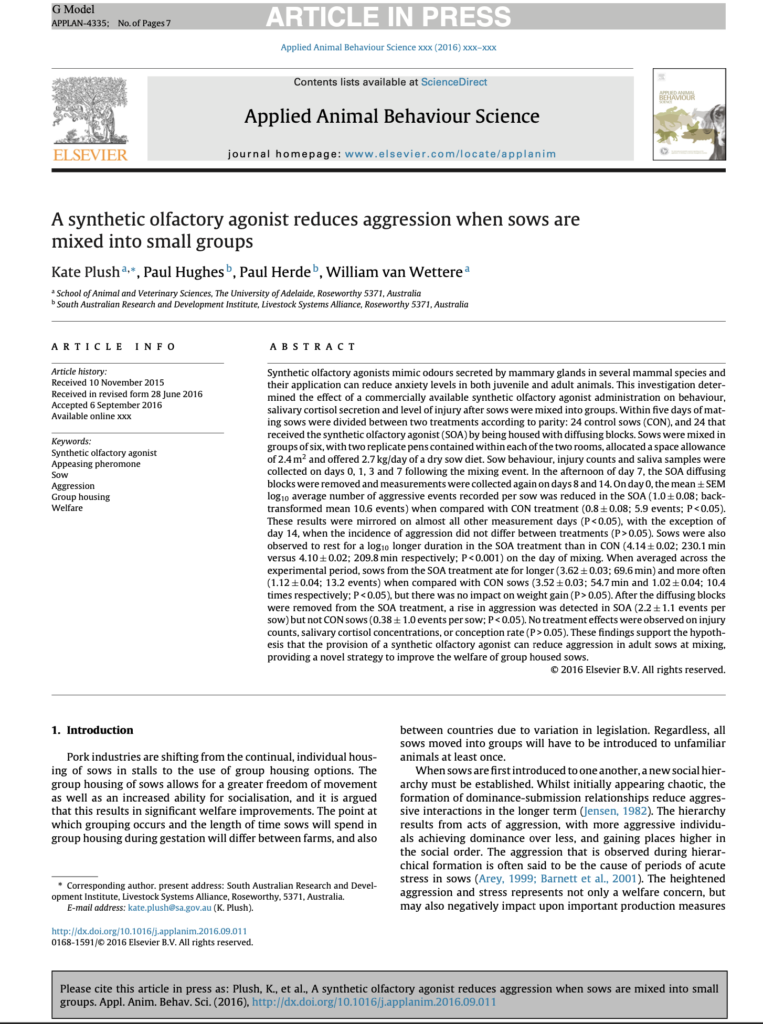Abstract:
Synthetic olfactory agonists mimic odours secreted by mammary glands in several mammal species and their application can reduce anxiety levels in both juvenile and adult animals. This investigation deter- mined the effect of a commercially available synthetic olfactory agonist administration on behaviour, salivary cortisol secretion and level of injury after sows were mixed into groups. Within five days of mat- ing sows were divided between two treatments according to parity: 24 control sows (CON), and 24 that received the synthetic olfactory agonist (SOA) by being housed with diffusing blocks. Sows were mixed in groups of six, with two replicate pens contained within each of the two rooms, allocated a space allowance of 2.4 m2 and offered 2.7 kg/day of a dry sow diet. Sow behaviour, injury counts and saliva samples were collected on days 0, 1, 3 and 7 following the mixing event. In the afternoon of day 7, the SOA diffusing blocks were removed and measurements were collected again on days 8 and 14. On day 0, the mean ± SEM log10 average number of aggressive events recorded per sow was reduced in the SOA (1.0 ± 0.08; back- transformed mean 10.6 events) when compared with CON treatment (0.8 ± 0.08; 5.9 events; P < 0.05). These results were mirrored on almost all other measurement days (P < 0.05), with the exception of day 14, when the incidence of aggression did not differ between treatments (P > 0.05). Sows were also observed to rest for a log10 longer duration in the SOA treatment than in CON (4.14 ± 0.02; 230.1 min versus 4.10 ± 0.02; 209.8 min respectively; P < 0.001) on the day of mixing. When averaged across the experimental period, sows from the SOA treatment ate for longer (3.62 ± 0.03; 69.6 min) and more often (1.12 ± 0.04; 13.2 events) when compared with CON sows (3.52 ± 0.03; 54.7 min and 1.02 ± 0.04; 10.4 times respectively; P < 0.05), but there was no impact on weight gain (P > 0.05). After the diffusing blocks were removed from the SOA treatment, a rise in aggression was detected in SOA (2.2 ± 1.1 events per sow) but not CON sows (0.38 ± 1.0 events per sow; P < 0.05). No treatment effects were observed on injury counts, salivary cortisol concentrations, or conception rate (P > 0.05). These findings support the hypoth- esis that the provision of a synthetic olfactory agonist can reduce aggression in adult sows at mixing, providing a novel strategy to improve the welfare of group housed sows.
Auteur: Kate Plush, Paul Hughes, Paul Herde, William van Wettere
En savoir plus: https://www.sciencedirect.com/science/article/abs/pii/S016815911630274X?via%3Dihub

